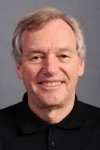Prof. Dr. Martin RICHARDSON
Prof. Martin RICHARDSON
Image: PrivateProf. Martin Richardson, Director of the Townes Laser Institute & College of Optics and Photonics, University of Central Florida, is visiting Jena in March and April 2012.
Martin Richardson graduated from Imperial College, London, in Physics (1964) and gained his Ph.D in Photon Physics from London University in 1967 as the first student to graduate in lasers under the advisement of the late Daniel Bradley. For his thesis, he studied the spectral characteristics of laser modes, investigated non-linear optical processes in dense plasmas, and developed a new high power dual frequency laser. Professor Richardson has held visiting scientific positions at the Max Born Institute in Berlin, the Institute for Laser Engineering (ILE) Osaka University, the Max Planck Institute for Quantum Optics in Garching, and other institutions in Australia, Canada, France, Qatar, and the former Soviet Union. He has published over 400 scientific articles in professional scientific journals and has presented numerous invited and plenary talks. He holds ~ 25 patents, with several pending and has chaired many international conferences including IQEC, ICHSP, and several SPIE meetings. He is a former Associate Editor of JQE, a recipient of the Schardin Medal, and a Fellow of OSA.
Lecture 1: Developments in New High Power Fiber Lasers and Ultrafast Lasers
Time: June 1, 2011, 14:00
Place: Carl-Zeiss-Saal, IOF, Albert-Einstein-Str. 7, 07745 Jena
Abstract: In this talk we will summarize the laser development activities in the areas of 2micrometer fiber lasers and ultrafast lasers. In a similar manner to high power Yb fiber lasers, thulium-doped fiber lasers are following a path of development towards high powers and efficiencies driven by advances in fiber production and high power diode pump technology. This presentation will summarize the current state-of the art in Tm fiber laser development, identify many of their future application areas. For the first time, it is possible to generate kW-level average powers in the "eye-safe" wavelength regime beyond 1.4 micrometer. Some applications in sensing, imaging and detection involve long distance propagation through the atmosphere, as the laser tuning range of thulium overlaps with a large atmospheric transparency window. Many molecular absorption lines fall within gain bandwidth of Tm, presenting a new high power laser tool for selective absorption and other processes in medicine and manufacturing. The >200 nanometer broad laser gain bandwidth of Tm:fiber is well suited for applications such as ultrashort pulse laser generation and amplification. This broad bandwidth and the capability to make high power narrow line lasers open new opportunities for spectral beam combining. We will summarize our activities in both these areas, as well as in some initial applications.
We will also describe a new generation of high power ultra-fast lasers that employ new concepts in pulse generation and amplification. Our developments are particularly focused towards quasi-single cycle operation with carrier envelope phase correlation (CEP). We will describe systems that employ hybrid architectures using Ti:Sapphire, fiber and solid-state amplifiers in OPCPA configurations that operate either with high repetition rates (>10kHz) or with high energies per pulse (>100 mJ). We'll briefly discuss the impact these systems will have on several areas of technology.
Lecture 2: Development of Tm Fiber Lasers
Time: March 27, 2012, 10:00
Place: Carl-Zeiss-Saal, IOF, Albert-Einstein-Str. 7, 07745 Jena
Abstract: This talk will summarize recent developments with high power cw and pulsed Tm fiber lasers performed in the Laser Plasma Laboratory of the Townes Laser Institute. The talk will cover the development of tunable high power cw 2 μm fiber lasers, and nanosecond and femtosecond pulsed Tm fiber lasers. Experiments using conventional and PCF fibers will be described. Some specific applications will be described. The talk will also include discussion of topics influencing the future progress of fiber lasers to higher power levels.
Lecture 3: Ultra-Fast Laser Materials Processing - Some New Investigations at the Fundamental Level
Time: March 30, 2012, 14:00
Place: Carl-Zeiss-Saal, IOF, Albert-Einstein-Str. 7, 07745 Jena
Abstract: This presentation will give an overview of current ultra-fast laser materials processing and interaction studies in the Laser Plasma Laboratory of the Townes Laser Institute. We will discuss a number of studies involving the interaction of femtosecond laser pulses from Ti;Sapphire and fiber lasers with transparent glasses, semiconductors, graphene and other materials. Research directions towards the fabrication of on-chip optical systems, waveguides, and applications of other types of materials modification will be discussed.
